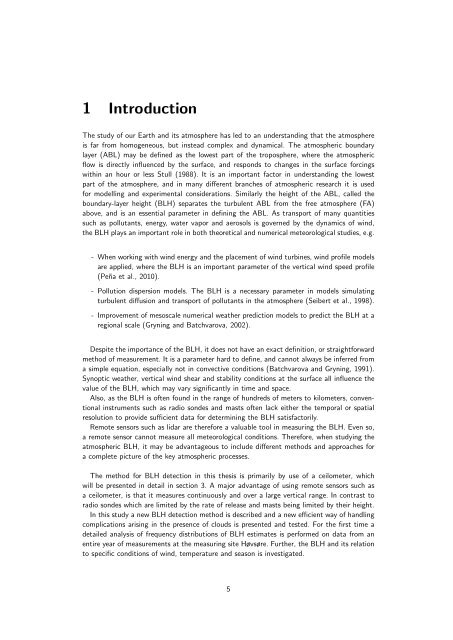Boundary-layer height detection with a ceilometer at a coastal ... - Orbit
Boundary-layer height detection with a ceilometer at a coastal ... - Orbit
Boundary-layer height detection with a ceilometer at a coastal ... - Orbit
Create successful ePaper yourself
Turn your PDF publications into a flip-book with our unique Google optimized e-Paper software.
1 Introduction<br />
The study of our Earth and its <strong>at</strong>mosphere has led to an understanding th<strong>at</strong> the <strong>at</strong>mosphere<br />
is far from homogeneous, but instead complex and dynamical. The <strong>at</strong>mospheric boundary<br />
<strong>layer</strong> (ABL) may be defined as the lowest part of the troposphere, where the <strong>at</strong>mospheric<br />
flow is directly influenced by the surface, and responds to changes in the surface forcings<br />
<strong>with</strong>in an hour or less Stull (1988). It is an important factor in understanding the lowest<br />
part of the <strong>at</strong>mosphere, and in many different branches of <strong>at</strong>mospheric research it is used<br />
for modelling and experimental consider<strong>at</strong>ions. Similarly the <strong>height</strong> of the ABL, called the<br />
boundary-<strong>layer</strong> <strong>height</strong> (BLH) separ<strong>at</strong>es the turbulent ABL from the free <strong>at</strong>mosphere (FA)<br />
above, and is an essential parameter in defining the ABL. As transport of many quantities<br />
such as pollutants, energy, w<strong>at</strong>er vapor and aerosols is governed by the dynamics of wind,<br />
the BLH plays an important role in both theoretical and numerical meteorological studies, e.g.<br />
- When working <strong>with</strong> wind energy and the placement of wind turbines, wind profile models<br />
are applied, where the BLH is an important parameter of the vertical wind speed profile<br />
(Peña et al., 2010).<br />
- Pollution dispersion models. The BLH is a necessary parameter in models simul<strong>at</strong>ing<br />
turbulent diffusion and transport of pollutants in the <strong>at</strong>mosphere (Seibert et al., 1998).<br />
- Improvement of mesoscale numerical we<strong>at</strong>her prediction models to predict the BLH <strong>at</strong> a<br />
regional scale (Gryning and B<strong>at</strong>chvarova, 2002).<br />
Despite the importance of the BLH, it does not have an exact definition, or straightforward<br />
method of measurement. It is a parameter hard to define, and cannot always be inferred from<br />
a simple equ<strong>at</strong>ion, especially not in convective conditions (B<strong>at</strong>chvarova and Gryning, 1991).<br />
Synoptic we<strong>at</strong>her, vertical wind shear and stability conditions <strong>at</strong> the surface all influence the<br />
value of the BLH, which may vary significantly in time and space.<br />
Also, as the BLH is often found in the range of hundreds of meters to kilometers, conventional<br />
instruments such as radio sondes and masts often lack either the temporal or sp<strong>at</strong>ial<br />
resolution to provide sufficient d<strong>at</strong>a for determining the BLH s<strong>at</strong>isfactorily.<br />
Remote sensors such as lidar are therefore a valuable tool in measuring the BLH. Even so,<br />
a remote sensor cannot measure all meteorological conditions. Therefore, when studying the<br />
<strong>at</strong>mospheric BLH, it may be advantageous to include different methods and approaches for<br />
a complete picture of the key <strong>at</strong>mospheric processes.<br />
The method for BLH <strong>detection</strong> in this thesis is primarily by use of a <strong>ceilometer</strong>, which<br />
will be presented in detail in section 3. A major advantage of using remote sensors such as<br />
a <strong>ceilometer</strong>, is th<strong>at</strong> it measures continuously and over a large vertical range. In contrast to<br />
radio sondes which are limited by the r<strong>at</strong>e of release and masts being limited by their <strong>height</strong>.<br />
In this study a new BLH <strong>detection</strong> method is described and a new efficient way of handling<br />
complic<strong>at</strong>ions arising in the presence of clouds is presented and tested. For the first time a<br />
detailed analysis of frequency distributions of BLH estim<strong>at</strong>es is performed on d<strong>at</strong>a from an<br />
entire year of measurements <strong>at</strong> the measuring site Høvsøre. Further, the BLH and its rel<strong>at</strong>ion<br />
to specific conditions of wind, temper<strong>at</strong>ure and season is investig<strong>at</strong>ed.<br />
5
















